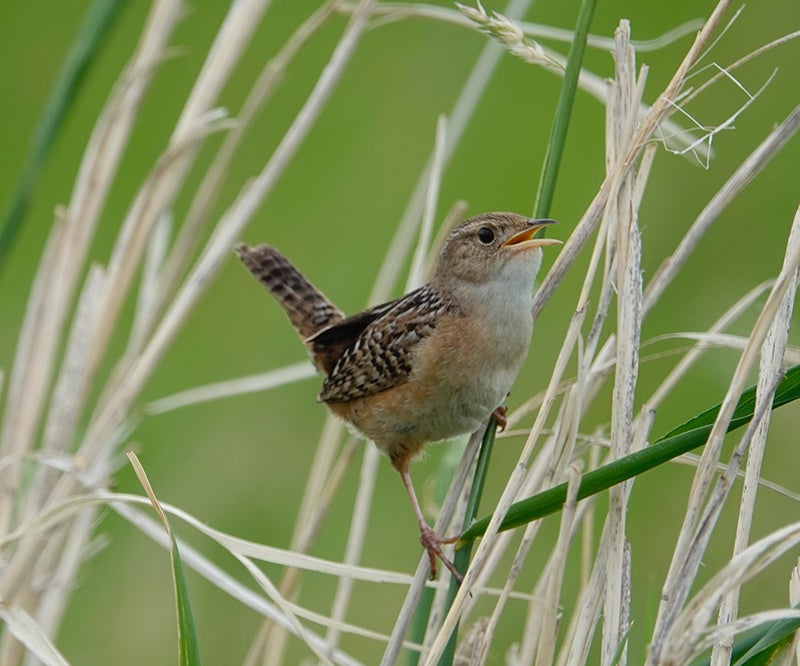Al Batt: Up a tree: Female mallard’s nesting spot more unusual than usual
Published 9:00 am Saturday, June 30, 2018

- Sedges have edges and sedges have wedge wrens. Al Batt/Albert Lea Tribune
Al Batt of Hartland is a member of the Albert Lea Audubon Society. Email him at SnoEowl@aol.com.
My neighbor Crandall stops by.
“How are you doing?” I ask.
“Everything is nearly copacetic. I’m trying to catch up on my loafing, but that’s not easy for someone known as the LeBron James of farming. I had a big bowl of mini-doughnuts for breakfast. I figured if Cheerios were good for me, these would be even better. You know, if I were Bill Gates, I’d be richer than he is.”
“What do you mean? How could you be richer?” I say.
“I’d still do a little farming on the side.”
Naturally
It’s summer, the hot season of our year. Summer comes from the Old English sumor, from the Proto-Germanic sumur, Old Saxon sumar, Old Norse sumar, Old High German sumar, Old Frisian sumur, Middle Dutch somer, Dutch zomer and German sommer.
A robin had begun singing at 4 in the morning. The bird had a strong work ethic. Each season of every year, I watch birds come and go. They are the heartbeats of the world and weave wonder into my life.
It was nearly bird-melting hot as I walked wet ground. Sedges have edges and clamorous sedge wrens. Insects hadn’t thoroughly bested me, but the deer flies were unrelenting as they tormented me. They go for the head and neck when biting people, inflicting a painful bite using knife-like mouthparts to slice the skin and feed on blood. Fortunately, deer flies aren’t a disease vector here, but some people suffer allergic reactions to the bites. In addition to humans, these biting flies also attack cattle, deer and horses. Deer flies are most common in June and July.
I visited a county park just to listen to the ethereal, flute-like songs of the wood thrush. Thoreau wrote of the wood thrush, “This is the only bird whose note affects me like music, affects the flow and tenor of my thought, my fancy and imagination. It lifts and exhilarates me. It is inspiring. It is a medicative draught to my soul. It is an elixir to my eyes and a fountain of youth to all my senses. It changes all hours to an eternal morning. I long for wildness, a nature which I cannot put my foot through, woods where the wood thrush forever sings, where the hours are early morning ones, and there is dew on the grass, and the day is forever unproved, where I might have a fertile unknown for a soil about me.”
Thoreau was singing my song.
Dave Lewis from Ohio told me that he had collection of photographs of fake owls on docks. He said they must be attracted to boats. I saw three on a dock recently. The imitation owls are like pet rocks. They do no good and they do no harm.
A cat prowled nearby. Australia has built the world’s longest cat-proof fence, hoping the 27-mile fence bordering the Newhaven Wildlife Sanctuary will help save endangered animals like the mala, a type of small wallaby, from feral cats. Researchers estimate that cats kill over a million birds each day in Australia.
I walked a trail in Wisconsin as winter wrens sang loud and endlessly. Three male scarlet tanagers landed on a log. Their vivid red colors made good company for the wren serenade. Good news of the family kind arrived via cellphone. We don’t get many perfect days. That was one. I was and am most thankful.
Q&A
Jill and Jerry Morstad of Albert Lea have a mallard hen nesting in one of their trees and wondered if that was common or if it was just a weird duck. As a weird duck myself, I understand weird ducks. Mallards nest in odd places, typically on the ground, but uncommonly in trees. The buck duck provides no assistance in incubating or duckling duties.
“How much does a fawn weigh at birth?” A white-tailed deer fawn weighs 5 to 8 pounds.
“How many times per second do hummingbird’s wings beat?“ The more than 300 hummingbird species found in North and South America flap their wings from 12 to 90 times per second.
“What is a flock of orioles called?” A group of orioles is collectively known as a pitch or a split of orioles.
“Do cowbirds eat insects off cows?” Maybe they do occasionally, but brown-headed cowbirds feed mostly on larger insects such as grasshoppers and beetles stirred into movement by cattle. Cowbirds also feed on seeds and grain.
“When could I expect to see baby skunks?” Eastern striped skunks give birth to a litter of four to six in May or early June. We begin seeing the babies (kits) when they are seven weeks old. Skunklets would be a perfect name for them.
Thanks for stopping by
“Stop letting people who do so little for you control so much of your mind, feelings and emotions.”— Will Smith
“If you truly love nature, you will find beauty everywhere.” — Laura Ingalls Wilder
Do good.


